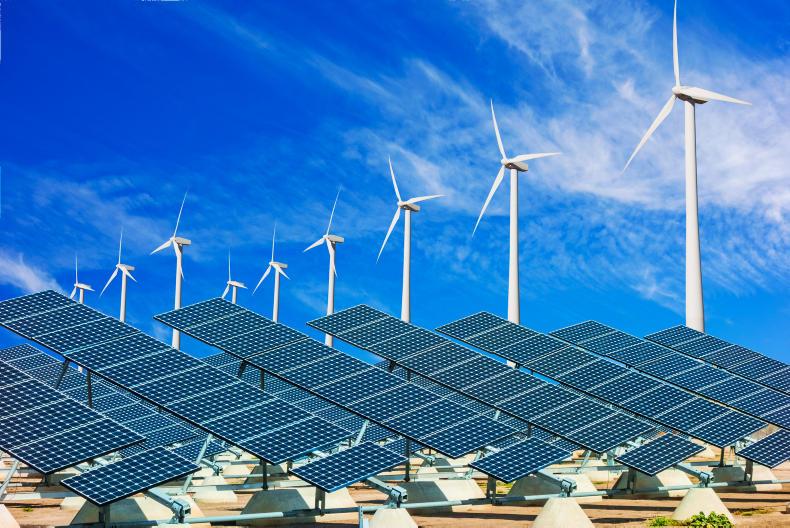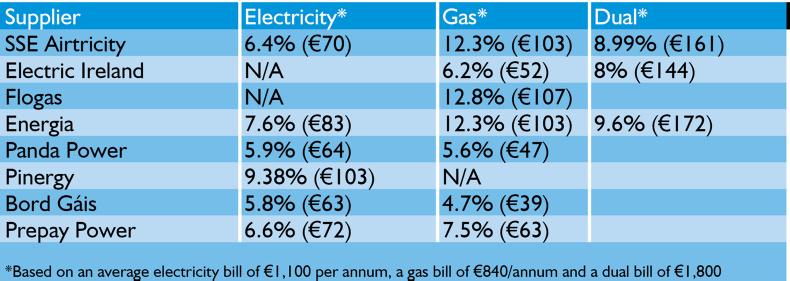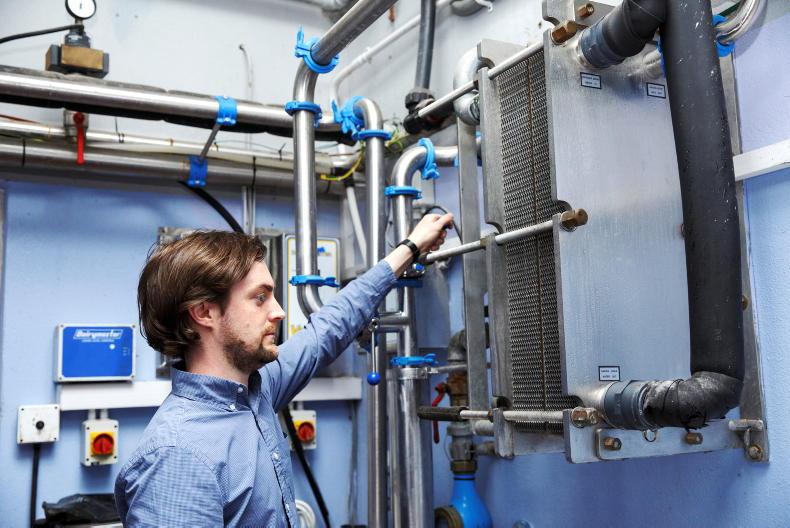The sound of post arriving on the carpet floor when there is an autumn nip in the air means for many families that gas and electricity bills are set to rise. Queue the sound of boilers firing up and lamps lighting the longer evenings.
This September though, as well as the usual seasonal increase, families will see their bills rise by between 5.80% and 9.38% for electricity, while gas prices are up by between 4.70% and 12.80%.
Unfortunately, it doesn’t matter who your provider is, these prices are increasing across the board.
So which consumers are going to see the biggest hit? As our chart outlines, Pinergy customers will see the biggest increase when it comes to their electricity bill, with a hike of 9.38%. When you consider this in terms of real money, if your electricity bill is averaging €1,100 a year (€91 p/m), you’re looking at €103 more. Those with Bord Gáis and Panda Power will see the most limited increase with 5.8% and 5.9% respectively, an increase of nearly €64.
Hikes are even more significant for gas customers. Those with Flogas, Energia and SSE Airtricity are looking at increases of over 12%. So taking an annual bill of €840 a year, with a set monthly fee of €70 a month, expect that bill to increase by €107.
Changes inevitable
There is no escaping these hikes as they all came into effect in August, but the real question is why are we now seeing these increases?
Daragh Cassidy, head of communications with Bonkers.ie, says: “A lot of this quite simply comes down to basic economics of supply and demand. Overall, the world economy is performing relatively well. With more people working, more factories in operation, there is, as a result, more demand for energy and, consequently, a higher price.”
However, there are also a variety of other factors at play that specifically apply to Irish consumers.
“There are lots of things that go into the price of fuel, it’s not just the raw material. For example, Ireland is an expensive country to do business in, more than other European countries. Rates, rents and overheads all get factored into the price.”
Ireland is also very vulnerable to international flux in price, as we still import our energy needs from abroad. Coal, gas and oil are obviously the three main ones, and this not only affects the fuel bill, but also the electricity bill.
Ireland has the sixth highest dependence in Europe on imported fossil fuels for electricity, so when the price of fuel goes up, so does our electricity bulls. Because of this reliance, we are more at the mercy of price movements. More than 30% of our energy is derived from renewable sources, but this is still an expensive way of generating energy.”

Whatever your opinions on nuclear energy, the fact also remains that because Ireland uses zero nuclear energy, we are again more reliant on fossil fuels. Compare this with other countries in Europe, where cheaper nuclear energy can represent up to a quarter of consumption
It can be challenging for energy companies to absorb fuel price increases, but are some hiding behind this excuse to pass even more costs onto the consumer?
Daragh says: “There is always that question, are they hiding? Certainly, I would like to see more clarity when it comes to the pricing model. For example, consumers in Britain are also seeing price hikes at levels of 5.7% for gas and 7.7% for electricity. However, these increases are not as significant as they are here. As we mentioned, there are some elements of this that are specific to the Irish consumer and furthermore, there are about 70 different energy suppliers in Britain, meaning more competition. Even so though, the Irish increases are significantly more.”
Switch to save
So what can consumers do? You might be blue in the face from hearing the term ‘switching is easy’, but the fact is, it is the most significant way to make a saving on utility bills over the course of a year.
The reason is quite simply, that many companies do not value loyalty. They are far more eager to get new customers than retain their own.
In fact, the savings are so significant, you could actually overcome the price hike that is coming your way.
Daragh says: “There are still heavily discounted plans available to customers who switch to a new supplier, along with ongoing discounts for things like paying by direct debit, always paying bills on time and opting to receive bills online.
“If you’re an average dual-fuel customer, you could save over €300 a year by switching from a standard tariff to the cheapest deals on the market.”
Internationally, how do we compare?
Gas
Romania – 3.02c for gas: €332.20/year. Irish consumers pay over €727 more a year.UK – 4.77c for gas: €524.70/year. Irish consumers pay over €534 more a year.Netherlands – 7.90 for gas: €869.0/year. Irish consumers pay €190 more a year.Electricity
UK – 17.18c for electricity: €721.56/year. Irish consumers pay over €166 more a year.Netherlands – 15.27c for electricity: €641.34. Irish consumers pay over €246 more a year.Iceland – 12.38c for electricity: €519.96. Irish consumers pay over €367 more a year – over 40% cheaper.
The sound of post arriving on the carpet floor when there is an autumn nip in the air means for many families that gas and electricity bills are set to rise. Queue the sound of boilers firing up and lamps lighting the longer evenings.
This September though, as well as the usual seasonal increase, families will see their bills rise by between 5.80% and 9.38% for electricity, while gas prices are up by between 4.70% and 12.80%.
Unfortunately, it doesn’t matter who your provider is, these prices are increasing across the board.
So which consumers are going to see the biggest hit? As our chart outlines, Pinergy customers will see the biggest increase when it comes to their electricity bill, with a hike of 9.38%. When you consider this in terms of real money, if your electricity bill is averaging €1,100 a year (€91 p/m), you’re looking at €103 more. Those with Bord Gáis and Panda Power will see the most limited increase with 5.8% and 5.9% respectively, an increase of nearly €64.
Hikes are even more significant for gas customers. Those with Flogas, Energia and SSE Airtricity are looking at increases of over 12%. So taking an annual bill of €840 a year, with a set monthly fee of €70 a month, expect that bill to increase by €107.
Changes inevitable
There is no escaping these hikes as they all came into effect in August, but the real question is why are we now seeing these increases?
Daragh Cassidy, head of communications with Bonkers.ie, says: “A lot of this quite simply comes down to basic economics of supply and demand. Overall, the world economy is performing relatively well. With more people working, more factories in operation, there is, as a result, more demand for energy and, consequently, a higher price.”
However, there are also a variety of other factors at play that specifically apply to Irish consumers.
“There are lots of things that go into the price of fuel, it’s not just the raw material. For example, Ireland is an expensive country to do business in, more than other European countries. Rates, rents and overheads all get factored into the price.”
Ireland is also very vulnerable to international flux in price, as we still import our energy needs from abroad. Coal, gas and oil are obviously the three main ones, and this not only affects the fuel bill, but also the electricity bill.
Ireland has the sixth highest dependence in Europe on imported fossil fuels for electricity, so when the price of fuel goes up, so does our electricity bulls. Because of this reliance, we are more at the mercy of price movements. More than 30% of our energy is derived from renewable sources, but this is still an expensive way of generating energy.”

Whatever your opinions on nuclear energy, the fact also remains that because Ireland uses zero nuclear energy, we are again more reliant on fossil fuels. Compare this with other countries in Europe, where cheaper nuclear energy can represent up to a quarter of consumption
It can be challenging for energy companies to absorb fuel price increases, but are some hiding behind this excuse to pass even more costs onto the consumer?
Daragh says: “There is always that question, are they hiding? Certainly, I would like to see more clarity when it comes to the pricing model. For example, consumers in Britain are also seeing price hikes at levels of 5.7% for gas and 7.7% for electricity. However, these increases are not as significant as they are here. As we mentioned, there are some elements of this that are specific to the Irish consumer and furthermore, there are about 70 different energy suppliers in Britain, meaning more competition. Even so though, the Irish increases are significantly more.”
Switch to save
So what can consumers do? You might be blue in the face from hearing the term ‘switching is easy’, but the fact is, it is the most significant way to make a saving on utility bills over the course of a year.
The reason is quite simply, that many companies do not value loyalty. They are far more eager to get new customers than retain their own.
In fact, the savings are so significant, you could actually overcome the price hike that is coming your way.
Daragh says: “There are still heavily discounted plans available to customers who switch to a new supplier, along with ongoing discounts for things like paying by direct debit, always paying bills on time and opting to receive bills online.
“If you’re an average dual-fuel customer, you could save over €300 a year by switching from a standard tariff to the cheapest deals on the market.”
Internationally, how do we compare?
Gas
Romania – 3.02c for gas: €332.20/year. Irish consumers pay over €727 more a year.UK – 4.77c for gas: €524.70/year. Irish consumers pay over €534 more a year.Netherlands – 7.90 for gas: €869.0/year. Irish consumers pay €190 more a year.Electricity
UK – 17.18c for electricity: €721.56/year. Irish consumers pay over €166 more a year.Netherlands – 15.27c for electricity: €641.34. Irish consumers pay over €246 more a year.Iceland – 12.38c for electricity: €519.96. Irish consumers pay over €367 more a year – over 40% cheaper. 











SHARING OPTIONS